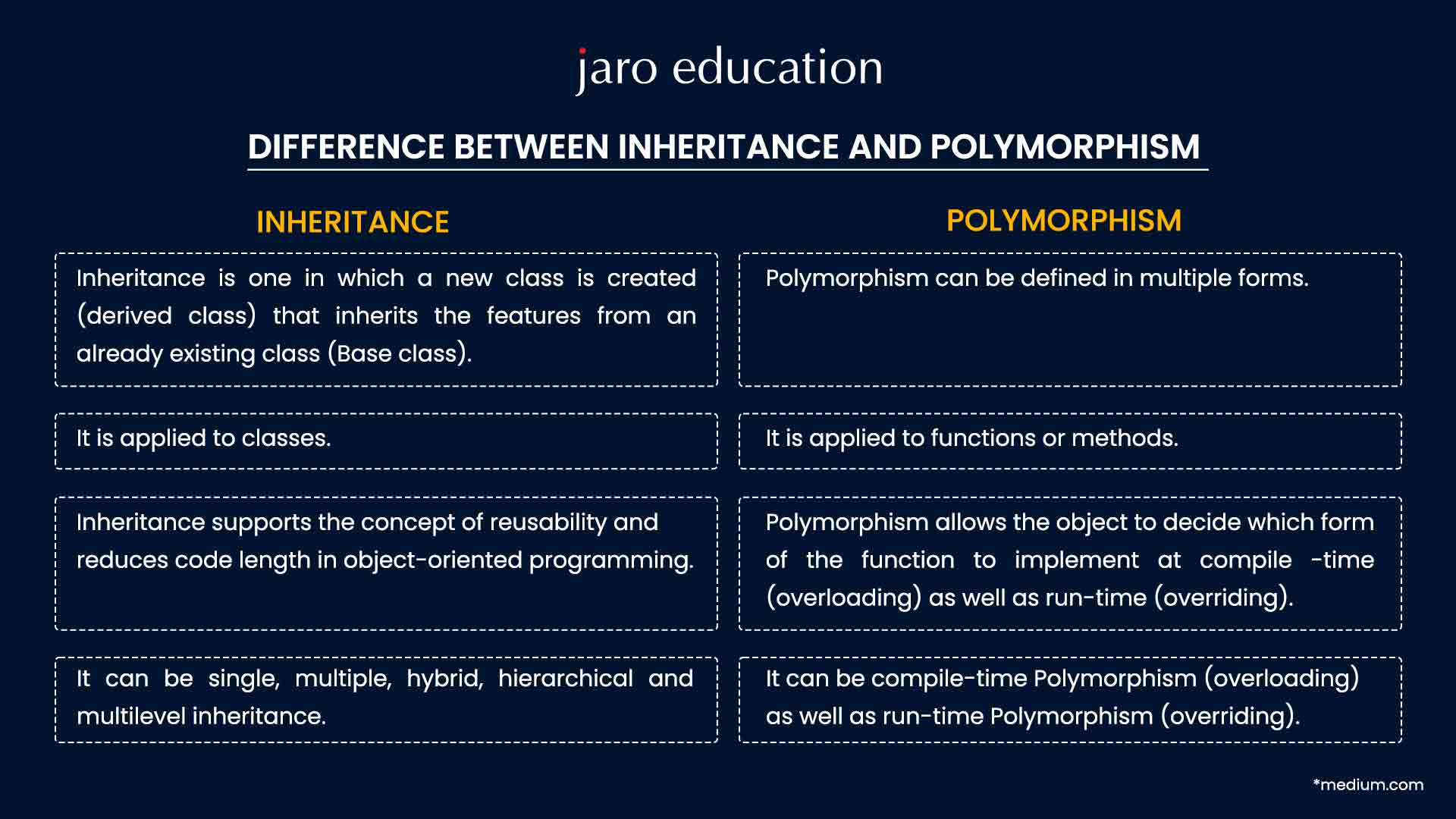Understanding Polymorphism in Modern Java Development
Table of Contents

- jaro education
- 24, January 2024
- 11:00 am
Polymorphism serves as a foundation in the field of Object-Oriented Programming (OOP). In the context of Modern Java Development, polymorphism encapsulates the profound ability of a single message to manifest in diverse forms. It empowers developers to execute a particular action in multiple ways, fostering flexibility and extensibility in software design. Polymorphism in Java stands out as a pivotal feature, exemplifying the dynamic nature of object-oriented languages. At its core, polymorphism enables the creation of a unified interface that accommodates multiple implementations, offering a spectrum of possibilities for developers to elegantly solve complex problems. In this article, we will see the intricacies of polymorphism, exploring its essence and various types in modern Java web development.
Types of Polymorphism in Java
There are two types of polymorphism in Java:
1. Compile-time Polymorphism (Method Overloading)
This type of polymorphism occurs during compile-time and involves the ability to define multiple methods in the same class with the same name but different parameter lists. The compiler determines which method to invoke based on the number, types, and order of the parameters. Method overloading enables developers to create more readable and concise code by providing multiple ways to call a method.
For example:
The Calculator class illustrates compile-time polymorphism by featuring two variations of the add() method. These distinct versions accept a different number of parameters, and the choice of which add() method to use is determined during the compilation phase based on the quantity of arguments provided.
When an instance of the Calculator class is created in the Test Polymorphism class, the add() method is invoked with either two or three parameters. The compiler decides, at compile time, which specific add() method to call, demonstrating the essence of compile-time polymorphism. This mechanism enhances code adaptability and clarity, allowing for multiple method definitions with the same name but varying parameter lists.
2. Runtime Polymorphism (Method Overriding)
Runtime polymorphism occurs during runtime and refers to a subclass’s ability to provide a specific implementation of a method defined in its superclass. This enables subclasses to extend or modify the behavior of their superclasses. The method signature of the overridden method in the subclass should be the same as the method signature of the method in the superclass.
For example:
The concept of runtime polymorphism is demonstrated through two classes: MacBook and iPad. MacBook serves as the parent class, while iPad is its child class. The child class overrides the method myMethod() inherited from the parent class. Notably, the instance of the child class is assigned to a reference of the parent class to showcase the dynamic behavior of runtime polymorphism.
At runtime, the myMethod() invocation is determined by the actual type of the object rather than the type of the reference variable. Despite the reference being of type MacBook, since it points to an instance of iPad, the overridden method in the child class gets called. This exemplifies how runtime polymorphism allows the selection of the appropriate method implementation based on the actual object type, enhancing flexibility and adaptability in object-oriented programming scenarios.

*data-flair.training.com
Real-life Examples of Polymorphism
Polymorphism, a fundamental concept in object-oriented programming, is not confined to the digital realm. Remarkably, it finds expression in various aspects of our everyday lives. Here are some compelling real-life examples that illuminate the essence of polymorphism:
1. The Multifaceted Role of Women in Society
Consider women in society as a poignant example of polymorphism. A single woman effortlessly transitions through diverse roles – she may be a devoted wife, a nurturing mother, a proficient manager in a professional setting, and more. The same individual seamlessly embodies multiple personas, showcasing the versatility akin to polymorphism.
2. The Adaptive Nature of Water
An elemental example lies in water’s ability to adapt to different states. At room temperature, water is a liquid, yet it transforms into a solid when frozen and transitions into a gas at its boiling point. This dynamic nature exemplifies polymorphism, as water assumes distinct forms under varying conditions.
3. Animal Communication Styles
Animals communicate in unique ways, each species demonstrating its distinctive vocalizations. For instance, a dog expresses itself through barking, a cow emits characteristic moos, and a cat communicates with distinctive meows. Despite the commonality of ‘speaking,’ the manifestation differs across species, embodying the principle of polymorphism.
4. The Swiss Army Knife of Technology: Smartphones
The contemporary smartphone epitomizes polymorphism in the technological realm. A smartphone seamlessly transforms into a multiplicity of tools acting as a phone for communication, a camera for capturing moments, a music player for entertainment, and more. Its capacity to adapt to diverse functionalities encapsulates the essence of polymorphism.
5. Human Behavior in Varied Contexts
Human behavior, too, serves as a compelling instance of polymorphism. Individuals exhibit different demeanors based on context – a person may adopt a casual disposition among friends, project a professional demeanor at work, and display respectful conduct in the company of seniors. This adaptability mirrors the polymorphic nature of human behavior.
In these real-life scenarios, polymorphism emerges as a dynamic and pervasive concept, transcending the boundaries of programming languages and seamlessly integrating into the fabric of our daily experiences.
Interfaces and Classes in Java
In Java, interfaces and classes serve distinct purposes in object-oriented programming, and one key distinction lies in their ability to support multiple inheritances. Unlike classes, interfaces can have multiple inheritances, allowing a class to implement multiple interfaces and thereby inherit their abstract methods.
For example, an interface named “salary” is created, defining an abstract method “insertsalary.” This method is intended to be implemented by any class that implements the interface. Two classes, SDE1 and SDE2, represent different levels of employees in a company and implement the “salary” interface. The “insertsalary” method in each class is overridden to set the salary for the respective employee type. The classes also have a “printSalary” method to display the inserted salary. In the main program (GFG class), instances of SDE1 and SDE2 are created, and their salaries are set using the “insertsalary” method. The “printSalary” method is then called to output the respective salaries. This implementation showcases the use of interfaces to enforce a common method signature (“insertsalary” in this case) across different classes, providing a structure for consistency in functionality while allowing each class to define its unique behavior.
Interfaces in Java offer a way to achieve multiple inheritances, enabling classes to implement multiple interfaces and inherit their abstract methods. This promotes code modularity and flexibility, as demonstrated in the provided example, where different employee classes share a common salary interface while maintaining individualized salary implementations.
Understanding Abstract Classes in Object-Oriented Programming
An abstract class serves as a blueprint for methods and variables within a specific class or object category. Objects, representing units of code, are encapsulated within a generic class in programming languages such as Java, C++, and C#.
Key Characteristics of Abstract Classes
- Abstract classes encapsulate one or more abstracted behaviors or methods, summarising objects or classes by focusing on relevant characteristics for the program’s operation.
- These classes enhance code cleanliness and efficiency by avoiding constant reference to irrelevant details, especially beneficial in object-oriented programming.
Usage and Benefits
- While not mandatory, abstract classes contribute to cleaner code and efficient programming, particularly when creating class hierarchies.
- Declared as abstract, these classes cannot be directly instantiated, preventing incorrect usage and requiring subclasses to define attributes necessary for instantiation.
- Subclasses derived from an abstract class inherit its attributes, fostering a hierarchy of classes through the concept of inheritance.
Creating Abstract Classes
- Abstract classes are created using the abstract keyword in the class definition, by inheriting from the abstract type, or by including an abstract method in the class definition.
- These classes stand in contrast to concrete classes, which lack abstract methods and can be directly instantiated for use in code.
- Abstract classes also differ from public classes, serving specific program parts, and superclasses, acting as roots for subclasses.
- Understanding abstract classes and their role in inheritance contributes to effective and modular object-oriented programming.
The Interplay Between Polymorphism and Inheritance in Java
The synergy between Inheritance and Polymorphism in the context of Java programming establishes a robust foundation for creating modular and adaptable code structures. In Java, Inheritance serves as a cornerstone for enhancing code reusability by allowing the creation of a base class from which other classes can get their properties and behaviors. This hierarchical structure enables derived classes to efficiently access and employ functions and variables defined in the base class, eliminating the need for redundant code. In essence, Inheritance in Java promotes the development of a more modular and easily maintainable codebase, facilitating the extension of existing functionality.
On the other hand, Polymorphism in Java introduces a layer of flexibility to the object-oriented paradigm. Going beyond the constraints of a fixed interface, Polymorphism enables a single function name to take on different forms through mechanisms such as overloading and overriding. While Inheritance in Java primarily operates within the realm of classes, Polymorphism extends its influence to methods and functions throughout the entire Java codebase. This versatility empowers developers to create functions that dynamically adapt to various scenarios, thereby enhancing the adaptability and robustness of the software.
The relation between Inheritance and Polymorphism in Java is evident when a base class defines a generic method and multiple derived classes implement variations of this method. Polymorphism comes into play as these derived classes exhibit different behaviors while adhering to a common interface. This harmonious relationship between Inheritance and Polymorphism empowers Java developers to design modular, reusable, and adaptable code, elevating the efficiency of the development process.

*medium.com
Architecting Efficient Solutions: Design Patterns Utilising Polymorphism
Design patterns leverage polymorphism, a fundamental principle in object-oriented programming, to provide flexible and reusable solutions to common software design challenges. Polymorphism allows objects of different types can be treated as examples of a common base type, enabling code to work seamlessly with various implementations of that base type. This concept has a crucial role in different types of design patterns
In creational design patterns, polymorphism is employed to create instances of families of classes without specifying their concrete classes. For example, the Abstract Factory pattern uses polymorphism to create families of related objects, allowing the client code to work with these objects uniformly without knowledge of their specific implementations.
Structural design patterns utilize polymorphism to compose classes and objects in a flexible manner. The Adapter pattern, for instance, enables the interaction between interfaces of different classes through a common interface, fostering polymorphic behavior and enhancing code extensibility.
In behavioral design patterns, polymorphism facilitates communication between objects by allowing them to interact without knowledge of each other’s concrete types. The Observer pattern, for instance, relies on polymorphism to enable a subject to notify multiple observers of state changes, providing a dynamic and extensible system.
Embracing polymorphism, design patterns promote code flexibility and reusability. The ability to substitute objects of different types through a common interface enhances the adaptability and maintainability of software systems. Despite criticisms of design patterns, their synergy with polymorphism remains a powerful approach to crafting scalable, maintainable, and efficient software solutions.
Best Practices for Preventing Polymorphic Virus Attacks
Collaboration between business owners and IT teams is crucial to mitigate the potential risks associated with polymorphic malware attacks. Employ the following best practices to bolster your security measures:
1. Implement Strategic IAM Policies
Define and manage access and permissions through strategic Identity and Access Management (IAM) policies.
2. Integrate Behavioral Monitoring into IAM
Make behavioral monitoring an integral component of IAM, enabling the detection of anomalous activities.
3. Invest in Security Programs with Signature Detection
Invest in security programs equipped with tools designed to identify the unchanging code “signatures” of polymorphic malware.
4. Utilise Tools for Detecting Viral Behaviors
Deploy tools capable of identifying viral behaviors, such as unauthorized downloads, unexpected program execution, or unusual user account activities.
5. Use AI and Machine Learning
Utilize AI and machine learning to enhance the speed and efficiency of malware detection.
6. Enhance Protection for Email and Collaboration Platforms
Strengthen security measures for email programs, productivity tools, and collaboration platforms to prevent potential entry points for malware.
7. Upgrade Legacy Systems
Replace outdated legacy systems with more secure solutions to reduce vulnerabilities.
8. Adopt Endpoint Detection and Response Tools
Implement endpoint detection and response tools to monitor, record, and analyze activities on endpoints.
9. Ensure Compliance of Third-Party Software
Ensure that third-party software adheres to internal security standards to maintain a secure environment.
10. Establish a Strict Updating and Patching Schedule
Create and adhere to a rigorous schedule for updating and patching all devices and programs to address vulnerabilities promptly.
By incorporating these comprehensive security measures, businesses can establish a resilient defense against polymorphic malware invasions. Given the evolving nature of threats, flexibility and adaptability are paramount, making a combination of meticulous access control, strategic identity management, and intelligent security solutions essential for safeguarding against attacks and preserving data privacy.
Case Studies of Polymorphism in Modern Java Development
Polymorphism in Java, exemplified through real-world scenarios, facilitates code simplicity and readability. In the context of a cellphone’s contact management system, the createContact() method showcases method overloading. It allows for the dynamic selection of the method definition based on the number of parameters passed—enabling the storage of one or two contact numbers under the same name.
In a shopping context, the analogy extends to class hierarchies. The ABCShoppingCenter class has a jeans() method, providing default Allen Solly jeans. Subclasses, such as XJeans and YJeans, demonstrate method overriding, allowing for variations like a new jeans variant in YJeans. The invocation of the jeans() method depends on the object type. ABCShoppingCenter objects offer default jeans, while YJeans objects provide both default and new variant options.
This polymorphic approach enhances code maintainability by consolidating functionality under a single method name. It mirrors the diversity of real-world scenarios, where objects of the same class exhibit different behaviors. This method of overloading and overriding contributes to the versatility of Java code, promoting modular and adaptable design.
These case studies highlight its practical application, emphasizing the importance of polymorphism in addressing varied programming requirements.
Systematic Troubleshooting Strategies for Polymorphic Issues
Troubleshooting polymorphic issues can be challenging due to the dynamic nature of polymorphism in programming. Here are some tips to help you identify and resolve such issues:
Review Code Logic
Carefully review the code where polymorphism is implemented. Check for any logical errors that might be causing unexpected behavior.
Check Method Signatures
Confirm that the method signatures match between the base class and derived classes. Polymorphism relies on method signatures being the same across classes.
Verify Inheritance Hierarchy
Ensure that the classes involved in polymorphism are correctly structured in terms of inheritance. A proper hierarchy is crucial for polymorphism to work as intended.
Use Debugging Tools
Employ debugging tools provided by your development environment. Set breakpoints and inspect variables during runtime to understand the flow of execution.
Test with Simple Examples
Create simple test cases that focus on the polymorphic behavior. Simplifying the code can make it easier to identify the root cause of the issue.
Check Input Types
If polymorphism involves method overloading, double-check the types of parameters being passed. Mismatched parameter types can lead to unexpected results.
Examine Exception Handling
Look into exception-handling mechanisms in place. Polymorphic issues might be masked by exception handling, so ensure that exceptions are appropriately caught and handled.
Update Dependencies
Ensure that you are using the correct and compatible versions of libraries and dependencies. In some cases, issues might arise due to version conflicts.
Use Logging Statements
Introduce logging statements at critical points in the code to trace the flow of execution and values of variables. This can help identify where the code deviates from the expected behavior.
Conclusion
Polymorphism serves as the foundation, blending adaptability and sophistication within the codebase. As developers utilize this powerful tool, the software’s structure reflects simplicity and scalability. In Java’s rich background, polymorphism emerges as the highlight, turning static constructs into a flexible, customized masterpiece that represents the epitome of modern programming artistry.
Online Master of Science (Information Technology) offered by Amity University is curated to provide a solid foundation for a transformative journey in modern Java development. Investigate polymorphism, web development, cybersecurity, and other topics by enrolling in this world-class program. Develop a vibrant career in academia, network administration, or Android/iOS development.






